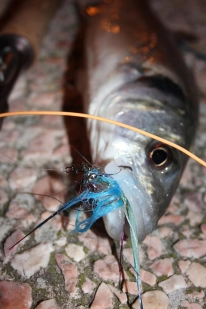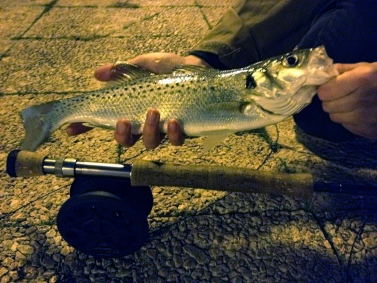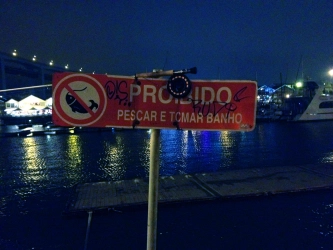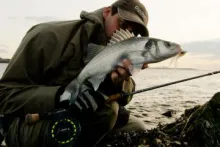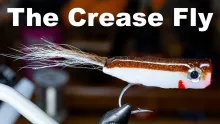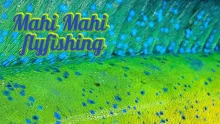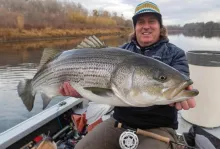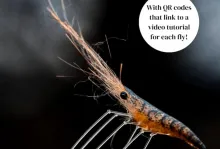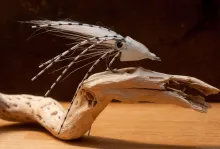Fishing for sea bass off the coast of Portugal - but never from a harbor.
"Maybe California has ruined you."
And perhaps it was true. With each lazy cast to the Atlantic - what to me all too much resembled a massive, featureless lake - I lamented the lack of diversity in species one could pursue on the fly. At most any point along the Golden State's coast are schools of mackerel; in the surf a few variations of perch and halibut; from a sufficiently large jetty or kayak one can target barracuda, striped and rock bass; anywhere stones littered the sea bottomed housed at least five species of rockfish; and Salmoniforms need not be listed.
Contrastingly, Portugal in the winter provides one species for the coastal fly angler: the European sea bass. Over the course of eleven days intermittently angling for this fish, my lamentation would give way to appreciation as I recognized the fish to be worthy of pursuit.
After a sleepless night we waited impatiently for a delayed plane. The weather had turned for the worse and our luggage sat on the tarmac for more than hour. So it was with great relief that within my first glimpse of the Atlantic ocean were ten to fifteen fish. Perched over the mouth of a harbor I could see their silhouettes slithering just beneath the calm water, ghosts of the littoral zone.
Baitfish burst across the surf. We quickly lined up.
Denni Koch
I don't remember the bite or if I'd set the hook because line had been taken, but the fight was adequate-- surely stronger than fish of comparable size from my home waters of Berlin. This first “robalo” would be, by far, the easiest caught.
Sea bass took a backseat to barbel, carp, and largemouth bass. We fished for them only when our journey took us near the coast and only when the wind permitted.
That initial luck would not reoccur. We could glean very little from observing the locals. Of the many hours we scouted the squadrons of Portuguese anglers "combat fishing" - casting as close to one another as decorum would allow - we saw only one man catch two fish.
Pilgrimages to fishing shops proved fruitless, as it was repeatedly communicated that robalo could not be taken by fly (only raising their tufted eyebrows perfunctorily after being shown our catches with clousers lodged in their mouths), and were dismissive of the idea one should localize casts based on features beneath and above the waves. Instead, it was repeatedly insisted that in order to catch robalo one needs to place a baited hook in the ocean for a sufficient amount of time.
Please, Portuguese readers, don’t take offense but as best as I can determine 90% of Portuguese fishing tactics has not progressed past the doctrine of "Place bait on a hook; put the hook in the water."
I discussed these observations with a shop owner and Portuguese national fishing champion. He explained it this way:"I think our country is many years behind other countries in fishing"
Therefore, I feel obliged to communicate some basic aspects of fly fishing for sea bass off the coast of Portugal during winter, not out of a sense of expertise, but because this might be the only resource for the hapless fly-angler in Portugal who finds him or herself, too, without guidance nor resources.
- Sea bass fishing is dictated by the tide. Fish the tide as it begins to rise, during it's peak and as it retreats. Those hours of lowest and highest tide are dead as the fish have returned to the deep.
- Follow the birds. If one observes cormorants hunting one can be sure sea bass are, also.
- Bait-fish patterns work well. Though my experience doesn't qualify me to discuss issues of pattern particulars, I am confident in stating that bait-fish pattern, especially those that dive, tied in "classic" ocean colors are effective.
-Unless a swarm of bait-fish is observed, fish low; fish near the bottom. In this way, clousers are perfect.
-If fishing near a harbor, fish the mouth. Sea bass rush into harbors during high tide hunting bait-fish.
-Don't fish harbors proper. It is absolutely illegal and if caught, which is likely as every major harbor is assigned a security guard at all times, your gear may be confiscated.
- Fish those places where the water becomes tumultuous or where cloudy water meets clear. It's here sea bass will ambush prey.
As the adage, "Wherever you go, there you are" further is true for anglers: "wherever you fish, there is your quarry." I would never recommend this combination of species, season, and country to my peers. However, nor would I prescribe denying oneself a session on the basis the fish are deep and the waves high.
Wade Whitaker
Hand picked for this article
- Log in to post comments

